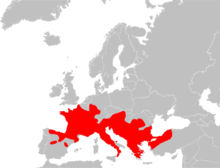Podarcis muralis
| Common wall lizard | |
|---|---|
 |
|
| Scientific classification | |
| Kingdom: | Animalia |
| Phylum: | Chordata |
| Class: | Reptilia |
| Order: | Squamata |
| Family: | Lacertidae |
| Genus: | Podarcis |
| Species: | P. muralis |
| Binomial name | |
|
Podarcis muralis (Laurenti, 1768) |
|
 |
|
| Native range of P. muralis in Europe | |
| Synonyms | |
|
|
The common wall lizard (Podarcis muralis) is a species of lizard with a large distribution in Europe and well-established introduced populations in North America, where it is also called the European wall lizard. It can grow to about 20 cm (7.9 in) in total length.
The common wall lizard is a small, thin lizard whose small scales are highly variable in colour and pattern. Its coloration is generally brownish or greyish, and may occasionally be tinged with green. In some individuals, the row of spots along their backs may form a line, while others may have a reticulated pattern with dark spots on the side and scattered white spots that can be blue in the shoulder region. The tail is brown, grey or rust in colour, and may also have light bars on the sides. The belly region has six rows of larger rectangular scales that are generally reddish, pink, or orangish. Common wall lizards may also have dark markings on the throat. This lizard has six distinct morphological forms which are identified by the colouration of its throat and underbelly. Three of these are pure morphs consisting only of solid colours on their scales: white, red (orange) or yellow, and three other morphs are distinguished by a combination of colours: white-yellow, white-red and yellow-red.
The common wall lizard prefers rocky environments, including urban settings, where it can scurry between rock, rubble, debris and buildings. In the southern part of its range it tends to occur in humid or semi-humid habitats, compared to drier habitats in the north.
Female wall lizards can discriminate between males with dissimilar levels of testosterone based on the scent alone, as females tongue-flick at higher rates towards females gland secretions of males with high levels of testosterone. Males with high levels of testosterone also produce higher amounts of secretion.
The six morphs of this lizard are primarily identifiable by colour and can be distinguished with the naked eye. However, they are commonly confirmed by digital photo and colour analysis. Source of colouration comes from different pigments within the lizard, with yellow colouration originating from carotenoids, and the expression of red/orange colour from pteridines. This is indicative that a phenomenon such as multiple alleles or epistasis may have a role in determining morphology. Morphs also differ in aspects other than colouration: differences between morphs are seen with femoral gland secretion, immune competence and body size. For males, colouration is visible on the underbelly, but in females of all the morphs there is less colouration seen in this region, indicating that sexual dimorphism occurs within this species.
...
Wikipedia

